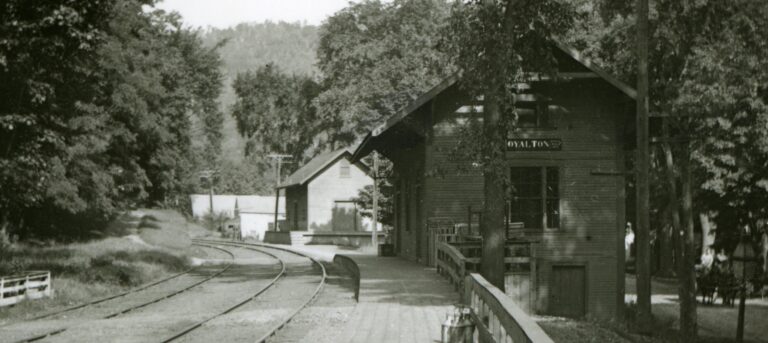This is Part II in a series titled “Seeking God in the Vermont Wilderness.” You can read Part I here.
My studies in local Royalton history have revealed some interesting tales of faith. One of the most remarkable stories I have discovered is about Sarah Joiner Lyman.
Sarah was born in Royalton in November of 1805 but would spend most of her life as a missionary in Hawaii.
On November 2, 1831, Sarah Joiner, age 25, a farmer’s daughter and teacher, married David Belden Lyman, 28 years old and a newly minted missionary, in the small rural community of Royalton, Vermont. The two traveled by stagecoach to Boston, whence they embarked on the whaling ship Averick bound for the Sandwich Islands … and the rest is history…
See: lymanmuseum.org/event/before-she-was-lyman-sarah-joiner-in-royalton-vermont/
Her journal and letters from 1830 to 1885 were compiled by one of her great-granddaughters, Margaret Greer Martin. They were published in 2009 by the Lyman Museum and can be read in the volume titled Sarah Joiner Lyman of Hawaii: Her Own Story. Her entries are an inside look into the struggles and triumphs of missionary life. At present I am about two-thirds of my way through the book. Below are a few gems I’ve underlined along the way.
On January 17, 1831 after having returned to Royalton after a stay of a couple of months in Boston with her husband and attending various foreign mission board meetings, she writes of her insecurities and feelings of unworthiness in God’s call to the mission field:
“Notes regarding becoming a missionary: Reasons why I should not engage in this great and glorious warfare. In the first place I have not been so decidedly pious as I ought, my influence has not been exerted in favour of religion, and if I neglect to improve upon the opportunities of doing good among my kindred and acquaintance, surely I am not a fit person to go on a mission. I am far inferior in point of mental cultivation, to many who are desirous of going. I have not the ability to do good that others have, I have not strong nerves, and this is certainly what a missionary ought to have. I very much doubt whether I have enough of a missionary spirit, and the thought of getting on to missionary ground, without being qualified for the work, and of course being useless, damps my zeal, and discourages me almost entirely about going, and this is almost the only thing that has kept me from coming to a fixed determination…”
(Her Own Story, 10.)
The journey to Hawaii was arduous. Voyages to the Pacific required travelers to go south of South America (pre-Panama Canal) to make their way to the Pacific. Her journal records some of the challenges of making such a voyage in the early 1800s:
“Many a wearisome night I have clung to the mattresses to prevent being thrown from my berth. Whilst the raging of the elements without prevented my closing my eyes to sleep, my mind has been filled with thoughts and feelings, altogether different from any I ever experienced before. The roaring of the sea, the howling of the wind among the masts and rigging, speak in a voice as loud as ‘seven thunders’ that there is a God. And that rideth upon the wings of the wind, and His footsteps are in the mighty deep. But the thought, He has perfect control of the elements, calms every fear, and I feel safe in His hands.”
(Her Own Story, 17.)
Upon arriving in Hawaii, Lyman takes time to share aspects of life from day to day. She records her efforts as a teacher at the writing school for natives and her struggles in learning the language. On occasion she shares of her homesickness:
September 22, 1832. “This is not the happiest week I have experienced on [foreign] ground. My time has been all occupied in performing or with a direct reference to performing missionary labor, and I am happy in my work, yet I have for several days felt an unusual depression of spirits, especially today. My thoughts have frequently turned on home and friends and happy country. Do I wish to return? No. Do I regret my undertaking? Not in the least. My attachment to my friends has not diminished at all; and when I look out upon the blue waters that separate us, my heart sinks with me. I cannot but weep that we are no more to meet in this world.”
(Her Own Story, 43-44.)
At the end of 1832, her first year on foreign soul, she writes looking back across the year and sees nothing but the faithfulness of God:
December 31, 1832. “The year 1832 is now gone… At its close I would call upon my soul and all within me to praise the Lord for his kindness to me and my dear husband, from the commencement to the present moment. One year ago tonight I was tossing on a bed of pain and sickness with but little prospect of recovery, but through the merciful kindness of that God whose compassions fail not, we have been spared to each other and permitted to labor together for the promotion of that cause for which our exalted Redeemer bled and died, and for which we left our beloved land. We take great delight in talking together of the long suffering and forbearance of Jehovah and of his mercies to us. O that we may enter upon the new year with hearts prepared to spend it in the fear and for the glory of our compassionate God.”
(Her Own Story, 49-50.)
In a letter to her sister, Melissa Joiner, in March of 1834, she writes of how she misses seeing her mother and father growing old. She also writes that she misses hometown Royalton customs such as enjoying “new made sugar at home” (Her Own Words, 66). Like so many missionaries, she writes of the feelings of failure and impotence in ministry. At the end of 1835 she journals:
“This day closes the year 1835. My heart is sad when I think that there has only been one individual admitted to the church during the whole year.”
(Her Own Words, 82.)
However, true to the apostle Paul’s words in Galatians 6:9, they persevere and in God’s perfect timing they begin to see fruit from their labors. In November of 1837 she writes:
“Sabbath Eve… 31 new members added to the church. The Holy Spirit is moving in the minds of the people. Oh, that many may be added to the Lord. Some of the individuals were from Laupahoehoe and some from the district of Puna. Almost all of them took scripture names. One of them by her own request was baptized Mary, after my mother…”
(Her Own Words, 97.)
In January of the following year, over 100 went under the waters of baptism.
I am yet to complete the book but I have so enjoyed it that I wanted to put some thoughts down. At points her journal reads something like an action novel. The Lymans face severe earthquakes on multiple occasions, she writes of dangerous, vile, seaman making port on the island, and they record the joy of childbirth and the sorrow of having to bury little ones. The Lyman Museum tells us the Lymans
“[W]ould establish a boarding school in Hawaii and host many important figures, including all of Hawaii’s monarchs from Kamehameha III to the last Queen of Hawaii, Liliuokalani. During their time in Hilo, they would even host the colorful Mark Twain who visited in 1866 while working for the Sacramento Union.50 The home that the Lyman’s built in Hilo, is the oldest frame structure on Hawaii Island today.”


